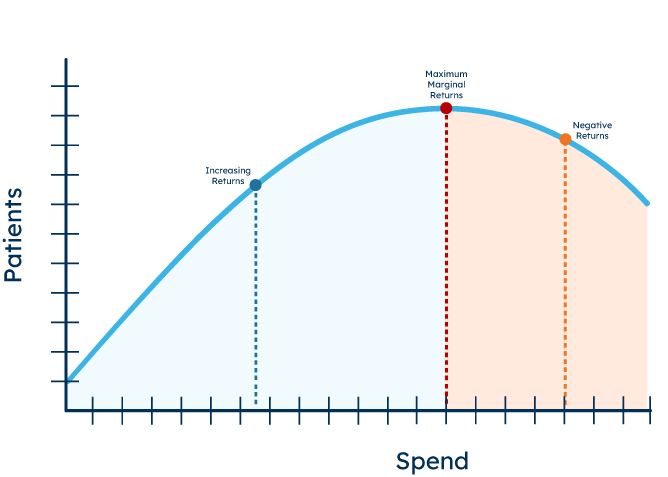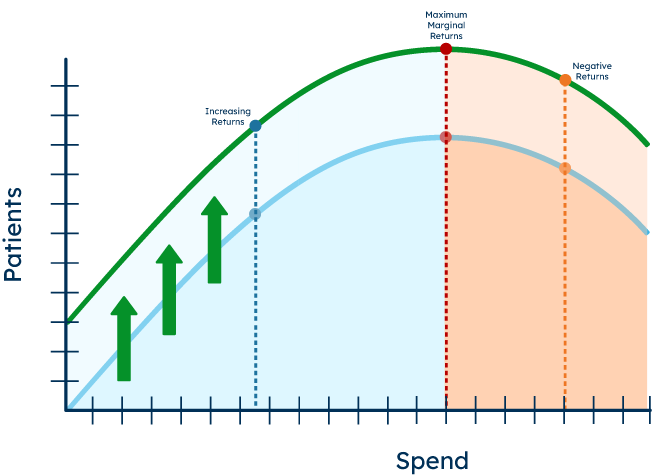
Healthcare marketing is a dynamic and complex field, requiring a strategic approach to maximize returns on investment (ROI). One crucial concept that healthcare marketers need to grasp is the idea of diminishing marginal returns, particularly in the context of various marketing channels. Understanding this concept is key to optimizing marketing efforts for better profitability and revenue.
Diminishing marginal returns occur when the incremental benefit from an additional unit of input (in this case, investment in a marketing channel) decreases as more of that input is invested. In healthcare marketing, this means that after a certain point, pouring more money into a specific channel yields progressively smaller increases in marketing outcomes, such as patient acquisition or brand awareness.
 Different Digital Marketing Channels, Different Returns
Different Digital Marketing Channels, Different Returns
The productivity phase of each digital marketing channel varies, just as it does with traditional methods. Let’s explore this in the context of different digital marketing types:
Measuring ROI and ROAS
Return on Investment (ROI) and Return on Ad Spend (ROAS) are critical metrics in assessing the efficiency of each marketing channel. ROI measures the overall profitability of the marketing efforts, while ROAS focuses on the revenue generated per dollar spent on advertising. By carefully monitoring these metrics, healthcare marketers can identify when a channel is approaching or has reached its point of diminishing returns.
 The Strategy of Optimization
The Strategy of OptimizationRegardless of the channel, monitoring ROI and ROAS is crucial. Digital marketing channels can offer more precise tracking and data analytics, making it easier to identify when a channel is nearing the point of diminishing returns. New methods in print or direct mail allow marketers to track ROAS down to individual actions.
In healthcare marketing, understanding and applying the concept of diminishing marginal returns is vital . By focusing on the most productive and cost-effective channels first, healthcare marketers can ensure they are not only reaching their target audience effectively but also doing so in the most financially prudent way. This strategic approach to channel optimization can lead to enhanced profit margins and overall revenue growth, ensuring a sustainable and successful marketing strategy in the competitive healthcare industry.
Before you start pouring dollars into campaigns, make sure you have an effective way to actually measure your returns–a challenging feat in a HIPPA-protected arena.
SocialClimb’s healthcare-specific platform provides you with the ability to measure the effectiveness of any marketing campaign through increases in patient appointments. We can help you follow patients from their first click on an ad to the operating room and beyond–in a HIPAA-compliant way! This insight into the patient journey will allow you to determine which marketing campaigns deserve your dollars and prove their value at your organization. Learn more about patient conversion tracking.
The original version of this page was published at: https://socialclimb.com/blog/understanding-diminishing-marginal-returns-in-healthcare-marketing-maximizing-profits-through-channel-optimization/
Easily attract the patients you want with SocialClimb’s automated, practice-friendly system. Our innovative tools take you to the top of online search results by getting you what search engines are... Read more
Local Marketing for HealthcareOne of the many factors you must consider when developing your healthcare organization’s marketing strategy is how well you expose target customers ...read more
During the COVID-19 pandemic, we would like to help your medical practice and your physicians configure your GMB listings at no charge. Communication during the COVID-19 pandemic ...read more
If you are not measuring the results of your healthcare marketing, you’re not marketing effectively. You may have been told that collecting healthcare marketing data is ...read more
SocialClimb’s ads expert shares advice on how to promote your business by running ads. Knowing where and how to start with healthcare advertising to promote your business ...read more